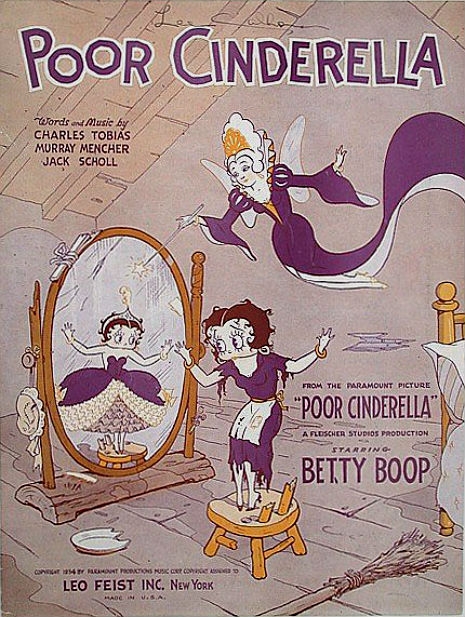
Of all the 110 Betty Boop shorts made by the Fleischer Studios between 1932 and 1939 (she was also seen in many of the Fleischer brothers’ earlier “Talkartoons”) only one of them—Poor Cinderella—was made in color. Although in the 1980s several Betty Boop cartoons were colorized—quite sloppily I might add—of her “classic era” it was just Poor Cinderella that was actually planned from the start to be a color film.
And. It. Is. Just. Amazing. Jaw-droppingly so. If it came out in 2016 let alone 1934, Poor Cinderella would be considered an absolute masterpiece. That animation was then still a pretty young field—Max and Dave Fleischer were leaders in animation production, giving Walt Disney his first real competition—the insane amount of technical prowess that went into making Poor Cinderella (produced by Max, directed by Dave) reveals it to be all the more impressive.
A celebrity cameo from famous crooner and radio personality Rudy Vallée, the Justin Bieber of the time.
First off, the film was made with the two-strip Cinecolor process. Walt Disney had locked up the rights to use Technicolor’s new 3-strip process from 1932 to 1935, but this limitation just makes the art direction look even better. It’s not so much a full color production, as one rendered in shades of black, white, blue and red. Again, it looks all the better for this, as you will see. Poor Cinderella has been in the public domain for many years, but always in scratchy, crappy-looking, less impressive versions. A recent HD transfer—part of the Betty Boop: Essential Collection 4 Blu-ray—gives us a clear glimpse of what a perfectly cut diamond this artistically and historically important short animation truly is. It’s like watching a moving stained glass window.
Second, Max Fleischer was the inventor of the Rotoscope—he patented the process in 1915—which aided in animating movement by tracing frames of live action film. One of the really impressive elements of Poor Cinderella—besides every single thing about it—is the way they did the backgrounds. Yes, with all the other near-psychedelic eye candy going on here, pay careful attention to the backgrounds. What they did was use their own proprietary in house “Stereoptical” camera—called the “Setback”—which was developed that year. Three-dimensional miniature sets were built to the scale of the animation artwork. Then the animation cels were placed within the setup so that the action could go around and among the sets. An ingenious tabletop animation process, in other words, at least partially.
For those of you reading this who are proficient in AfterEffects or 3D animation, imagine having to work like this! Clearly the Fleischer brothers were complete maniacs.
Trust me, you don’t have anything better to do for the next ten minutes than to watch Poor Cinderella. I’m quite sure of it:
Now if you’ve read this far, chances are that you have an interest in either Betty Boop or Max Fleischer’s work in general, so please allow me to call your attention to former Captain Beefheart/Jeff Buckley guitarist Gary Lucas’ latest release, Fleischerei: Music from Max Fleischer Cartoons, out now on Cuneiform Records.
It’s a delightful, toe-tapping, madcap and yes, very cartoony musical experience. I’ve had the Fleischerei CD sitting on my desk for weeks and I only got around listening to it this past weekend as I was cleaning up around the house. I really got into it. You never know how something like this will work, but Lucas’ unusual project works spectacularly well. I don’t think I’ve ever had such a good time cleaning. So, so good.
The legendarily inventive guitarist’s principal collaborator in Fleischerei, his “riotous jumble of low down, Harlem jungle jazz, Yiddish music hall turns, Tin Pan Alley and Broadway show tunes and a soupcon of klezmer” acoustic ensemble is 2015 Emmy-nominated Broadway actress/singer Sarah Stiles, who does an amazing Betty Boop (and Olive Oyl, too. Both characters originally voiced by Mae Questel.) Additionally, Sesame Street musical director Joe Fiedler, the trombonist in the Captain Beefheart tribute group Fast ‘N’ Bulbous, has lent his considerable musical arranging talents to the party. The level of musicianship is very high here. Lucas is at his best, clearly having tons of fun and playing some amazingly dexterous and inventive things on his guitar. If this was strictly an instrumental album, it would be a damned good one, but with Stiles exhuberant vocals providing both, in the words of Lucas: “the icing and the cherry on top” it becomes something truly special and big fun.
Below, Gary Lucas and Sarah Stiles perform “Don’t Take My Boop-Oop-a-Doop Away” from ‘Fleischerei’ at the Cornelia Street Cafe in NYC.
Fleischerei performing “The Music Goes Round and Round” live in Long Island:
Fleischerei live at the BAM Cafe in New York: